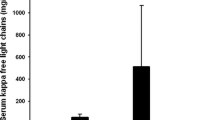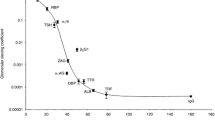Abstract
Renal failure (RF) in multiple myeloma (MM) is considered an ominous complication even though, when timely therapy is started in patients with minimal damage, a high percentage of cases can achieve a regression. The evaluation of renal involvement usually relies on serum creatinine or its clearance, but these parameters have proved to be inadequate to identify initial damage. The aim of this study was to assess the role of the following urinary proteins in diagnosing renal impairment at an early stage: high-molecular-mass proteins (transferrin, IgG, albumin) as markers of glomerular damage, and low-molecular-weight proteins and parenchymal enzymes [α1-acid glycoprotein (AGP), α1-microglobulin (α1M), retinol-binding protein (RBP), β2-microglobulin (β2M), lysozyme (LZ), and N-acetyl-β-d-glucosaminidase (NAG)] as indicators of tubular disorder. Thirty MM patients (nine at disease onset and 21 previously treated) were included in the study. No correlation was found between the urinary proteins and the phase or the stage of the disease. By the Spearman test, Bence Jones proteinuria correlated significantly with the 24 h proteinuria (p=0.01) and β2M (p=0.02), and weakly with the α1M. Serum creatinine concentrations and urea correlated with most of the analytes evaluated: RBP correlated well with urea (p=0.004) and creatinine (p=0.004); IgG (p=0.006) albumin (p=0.009), AGP (p=0.04), and NAG (p=0.02) correlated with serum creatinine. Significant statistical correlation was found between all the analytes except LZ and the creatinine clearance. Twelve of the 30 MM patients (40%) showed abnormal values of urinary proteins. Four of these patients showed overt renal failure with significant modification of the serum parameters and of creatinine clearance, three showed an isolated decrease of creatinine clearance, and five did not present any alteration of serum or urinary parameters. This testifies to the utility of urinary proteins in highlighting renal damage even in cases where the customary serum indicators of renal disorder are normal. In conclusion, our results demonstrate that AGP, RBP, NAG, transferrin, and IgG are good indicators of renal damage. They do not correlate with the severity of the disease, but they seem to be helpful in identifying a subset of patients with initial renal dysfunction.
Similar content being viewed by others
Author information
Authors and Affiliations
Additional information
Received: November 9, 1998 / Accepted: March 5, 1999
Rights and permissions
About this article
Cite this article
Corso, A., Serricchio, G., Zappasodi, P. et al. Assessment of renal function in patients with multiple myeloma: the role of urinary proteins. Ann Hematol 78, 371–375 (1999). https://doi.org/10.1007/s002770050531
Issue Date:
DOI: https://doi.org/10.1007/s002770050531




